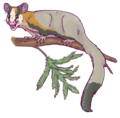Amphitheriidae
Appearance
(Redirected from Amphitheriid)
| Amphitheriidae Temporal range: Middle Jurassic,
| |
|---|---|

| |
| Scientific classification | |
| Domain: | Eukaryota |
| Kingdom: | Animalia |
| Phylum: | Chordata |
| Class: | Mammalia |
| Clade: | Prototribosphenida |
| Order: | †Amphitheriida Prothero, 1981 |
| Family: | †Amphitheriidae Owen, 1846 |
| Genera | |
Amphitheriidae is a family of Mesozoic mammals restricted to the Middle Jurassic of Britain, with indeterminate members also possibly known from the equivalently aged Itat Formation in Siberia and the Anoual Formation of Morocco. They were members of Cladotheria, more derived than members of Dryolestida, and possibly forming a close relationship with Peramuridae.[1] Amphitheriidae is the only family of the order Amphitheriida.
Classification
[edit]Cladogram after Panciroli et al. 2018:[1]
| Cladotheria |
| ||||||||||||||||||||||||||||||||||||
Cladogram after Magallanes et al, 2024:[2]
| Cladotheria |
| ||||||||||||||||||||||||||||||||||||||||||||||||
References
[edit]- ^ a b Panciroli E; Roger B.J. Benson; Richard J. Butler (2018). "New partial dentaries of amphitheriid mammalian Palaeoxonodon ooliticus from Scotland, and posterior dentary morphology in early cladotherians". Acta Palaeontologica Polonica. 63 (2). doi:10.4202/app.00434.2017.
{{cite journal}}: CS1 maint: multiple names: authors list (link) - ^ Magallanes, Isaac; Beard, K. Christopher; Martin, Thomas; Luo, Zhe-Xi (2023-09-03). "A new dryolestid fossil from the Late Jurassic illuminates molar root structure of dryolestids". Journal of Vertebrate Paleontology. 43 (5). doi:10.1080/02724634.2024.2322740. ISSN 0272-4634.
Further reading
[edit]- Zofia Kielan-Jaworowska, Richard L. Cifelli, and Zhe-Xi Luo, Mammals from the Age of Dinosaurs: Origins, Evolution, and Structure (New York: Columbia University Press, 2004), 14,395.
- Close RA., Davis BM., Walsh S., Wolniewicz AS., Friedman M. and Benson RB. 2016. A lower jaw of Palaeoxonodon from the Middle Jurassic of the Isle of Skye, Scotland, sheds new light on the diversity of British stem therians. Palaeontology, 59, 155-169






